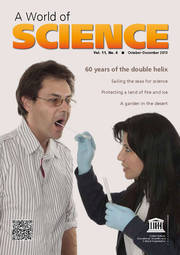Vol 11, No. 4 [October-December 2013]
| EDITORIAL |
Genetics, genomics: where to from here?
When his newborn son was rushed to intensive care with breathing problems in 1999, American Jonathan Rothberg feared a genetic disease might be the cause. It wasn’t and his son recovered but, while waiting anxiously for the diagnosis, Dr Rothberg had a brainwave: he would develop a portable machine able to screen a person’s genome in just a few hours – or even minutes.
He isn’t there yet but his printer-sized device can nevertheless sequence the genome of a bacterium or virus in record time. That is already a leap forward, when you consider how many days it takes to culture bacteria. Imagine how much faster you could identify the cause of an epidemic, if you could sequence the microscopic suspect’s genome in just a few hours.
Next-generation genomics offers exciting possibilities for medicine but also for agriculture – and for criminals or terrorists, if the technology fell into the wrong hands. Those hands might even be well-intentioned but ignorant of the dangers of experimenting with DNA sequencing or with assembling genes to customize new organisms, what is known as synthetic biology. These new organisms could escape from a backyard garage into the environment, where they could contaminate other species – the stuff horror movies are made of. Each new technology poses ethical challenges.
UNESCO’s International Bioethics Committee (IBC) plans to enhance collaboration next year with its sister Commission on the Ethics of Science and Technology, in order to reflect on overarching topics, such as the risks associated with synthetic biology and converging technologies, which blend nanotechnologies, biotechnologies and ICTs − as in the case of next-generation genetic screening devices.
There are also questions of access. Will genetic screening be too costly for the poor, for instance? As the Chair said when the IBC met in June,’ the issue of financial gain from the human genome is a looming conflict between intellectual property rights and the right of every human being to have access to quality health care’.
All three international declarations on bioethics adopted by UNESCO since 1997 reaffirm the same overriding principle: respect for human dignity. The IBC is currently putting together policy recommendations for prohibiting the commercial exploitation of the human body, including via organ trafficking or the sale of biobanks.
UNESCO’s involvement in the biological sciences dates back much farther than the 1990s, of course. By anticipating the revolution in applied microbiology in the 1970s that followed the discovery of the molecular structure of DNA in 1953, UNESCO’s biological sciences programme was well-prepared for the emergence of genetic engineering. As early as 1962, UNESCO launched the International Cell Research Organization. The Molecular and Cell Biology Network followed in 1990, the first centre of its kind to function under the auspices of UNESCO after becoming an NGO in 2002. In the early 1980s, UNESCO threw its support behind the fledgling Human Genome Project, which would hail the birth of genomics. Today, UNESCO’s International Basic Sciences Programme is supporting the successor to the Human Genome Project, the Human Variome Project, which is mapping genetic variation in the human population to improve diagnostics.
Last June, UNESCO celebrated these three milestones by hosting an event in Paris on Sixty Years of DNA, from the Double Helix to the Human Variome, through the Human Genome. We retrace this extraordinary journey in the article beginning overleaf.
Gretchen Kalonji
Assistant Director-General for Natural Sciences






